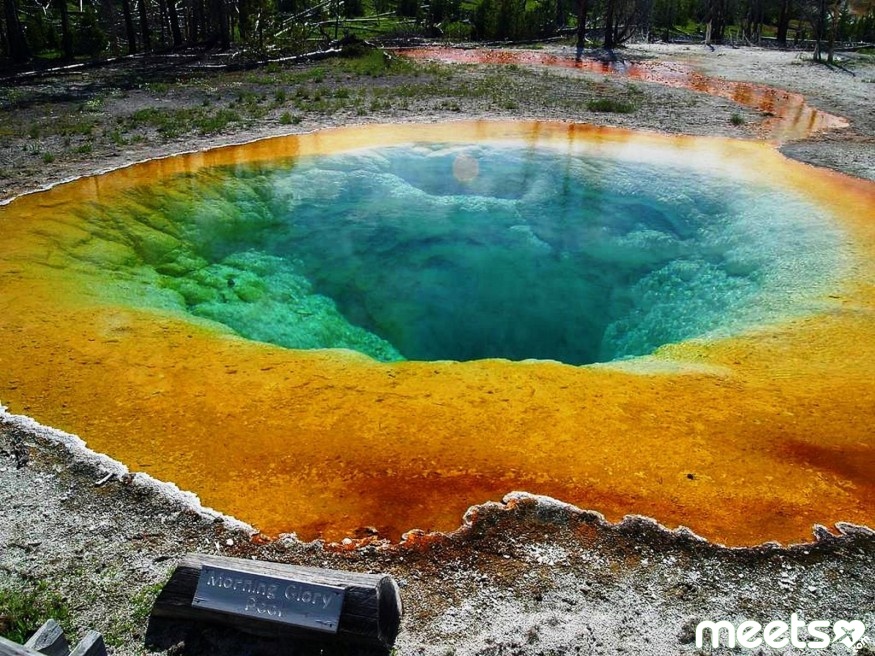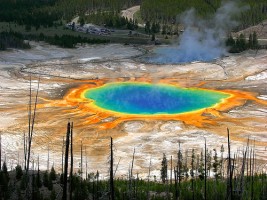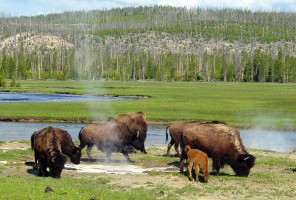In 1807, a hunter being in search of fur-bearing animals came to Yellowstone plateau surrounded by mountain ranges of the Rocky Mountains. On his way he met drenched with lava canyons, gleaming obsidian rocks and petrified wood. Here he saw rising foamy streams of steam from crevices and volcanic craters were full of bubbling water. Specific hydrogen sulfide odor was over hot springs.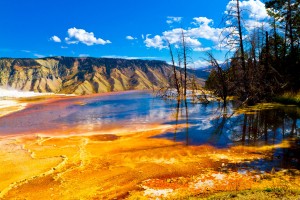 This mysterious and ghostly landscape strikes fear into the hunter’s soul. “All the time it seems as if the land between the fountains mud opens wide, and you fail somewhere in hell” – so hunter described his frequent trips to the Rockies in northwestern Wyoming. Contemporaries considered the hunter’s story unreal. Statements that “trees & grass are like stones”, “fountains of boiling water spray out of the ground”, “caught a fish, put it into boiling water and your dinner is ready” and the description of other miracles resembled stories in the style of Captain Vrungel. Only in the 1870s, when several scientific expeditions were sent to the area of Yellowstone, they confirmed the accuracy of the “hunting tales,” The Valley of Geysers was declared a national treasure. In 1872, US President Ulysses S. Grand signed a decree establishing the world’s first national park.
This mysterious and ghostly landscape strikes fear into the hunter’s soul. “All the time it seems as if the land between the fountains mud opens wide, and you fail somewhere in hell” – so hunter described his frequent trips to the Rockies in northwestern Wyoming. Contemporaries considered the hunter’s story unreal. Statements that “trees & grass are like stones”, “fountains of boiling water spray out of the ground”, “caught a fish, put it into boiling water and your dinner is ready” and the description of other miracles resembled stories in the style of Captain Vrungel. Only in the 1870s, when several scientific expeditions were sent to the area of Yellowstone, they confirmed the accuracy of the “hunting tales,” The Valley of Geysers was declared a national treasure. In 1872, US President Ulysses S. Grand signed a decree establishing the world’s first national park.
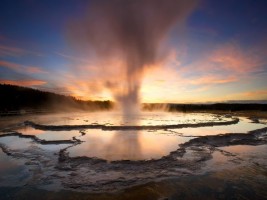 Yellowstone National Park – boiling mud soup from the Earth interior
Yellowstone National Park – boiling mud soup from the Earth interior
Today Yellowstone – the national park, and an international biosphere reserve and the object, a UNESCO World Heritage Site. It covers an area of 8983 km². Yellowstone is at the bottom of a giant bowl bounded from all sides by snow-capped mountain peaks height of which is from 2700 to 3400 meters above sea level. Yellowstone River (“Yellow Stone”) flows from these mountains, in the upper stream it forms waterfalls and deep canyons, framed by a yellow rocks. This river gave its name to this reserve – Yellowstone. Besides such a mysterious landscape, this place is a real “powder keg” of the planet. A phenomenon of Yellowstone obliged oversupply of molten magma that lies beneath the earth’s crust, very close to the surface of the earth. 642,000 years ago, when molten rock overflowed magnetic center, there was a catastrophic volcanic eruption. Lava, ash and chunks of rock flew up into the sky with such force that even today in the western and central states can be found layers of volcanic rocks. “Cork” which plugged the magma exploded, and in its place a giant hollow with steep walls known as Yellowstone Caldera was formed. Hot springs are inside the crater and besides volcanic gases dissolved in the magma flow out through the crust of cooled lava streams. Like the broth in the boiling pot, clay soil boils steam in steam breathing bowels.
Geothermal phenomena in Yellowstone Park are certainly the most grand in the world – there are 3000 geysers and about 10,000 geothermal sources such as mud volcanoes, hydrogen sulfide streams and others. Also Yellowstone geyser fields are found only in four places on the planet – in Iceland, Chile, New Zealand and the Valley of Geysers in Kamchatka. The most powerful geyser of Yellowstone throws up to 4 thousand tons of water to a height of 100 meters during the eruption! Yellowstone geothermal pools look like puddles, but differ in color, size, shape and chemical composition. The color of the reservoirs is due to brightly colored bacteria and algae that live in hot water. The most famous ponds in the park – is Ipomoea, or Morning Glory Pool and Black Pool. Morning Glory Pool, similar in shape to a full-blown flower of morning glory, which periodically changes its colors and explodes like a geyser. It is possible not only to drown in it (depth is up to 7 meters), but also boil – Ipomoea water temperature reaches 90°C. Black Pool is a gaping black abyss filled with pearl-blue water. A Grand Prismatic Spring – the third largest in the world – is represented by all colors of the rainbow. At the northern boundary of the National Park are Mammoth Hot keys. Over the tens of thousands years hot water gradually dissolved calcite contained in the rock, forming a picturesque terraces, cascades coming down a steep slope. The deposition of calcareous salts takes place with astonishing rapidity: stone, dropped into the water at night, in the morning covered with sparkling crystal particles.
Yellowstone is no less rich in fauna too. Wolves, lynx, cougars, deer, moose walk around. There are several hundred heads of bison in herds. In the park and outside of it there are about 600 grizzly bears. In the river valley settled hares, foxes, coyotes, otters, squirrels. Here are found playful meadow dogs and ground squirrels. For a half century, protected mode animals have forgotten how to fear man and willingly accept food from the hands of tourists. The park nesting swans and cranes. In the sky eagles are soaring, and in freshwater lakes pelicans are splashing. Rivers are home to 18 species of fish, including salmon. There exists a little place on earth where it would be gathered at the same time so much natural beauty, as in Yellowstone. It is no coincidence the local Indians named this wonderful place “kingdom of ice, fire and brimstone.” However, Yellowstone – it is not the wilderness with a minimum of creature comforts. Here are the roads, hotels and museums – everything for tourists and visitors.

